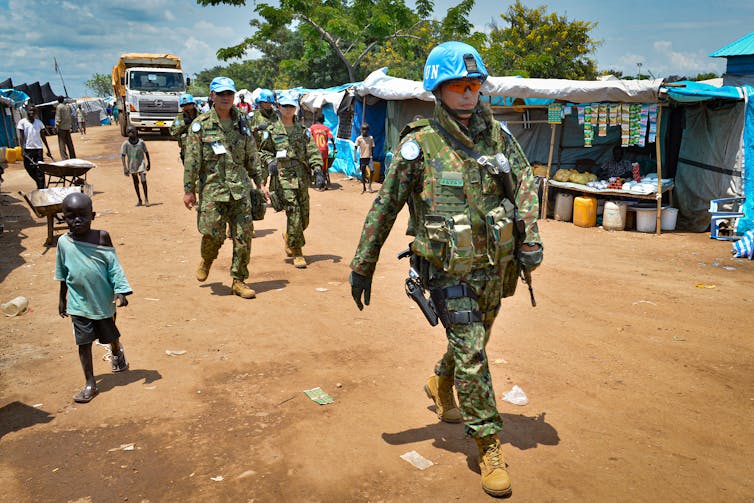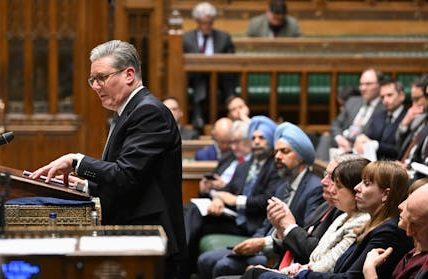Japan’s shifting memory of the second world war is raising fears of renewed militarism
Eighty years have passed since Japan’s surrender ended the second world war. But the way Japan thinks about its wartime history is changing at pace. This is coinciding with a political shift that risks renewed Japanese militarism, an outcome that would complicate politics across east Asia.
Japan’s traditional narrative of the war originated in the post-war occupation, a period in which the US oversaw the demilitarisation of Japanese society. These efforts included the establishment and adoption of Japan’s current constitution in 1947.
Article 9 of the constitution renounces the use of force as a means of settling international disputes, thus limiting the Japanese military to being a purely defensive organisation. Japan has upheld Article 9 since its inception, transforming itself into a pacifist nation and pursuing a humanitarian and diplomatic foreign policy.
Tokyo refused to send personnel even for UN peacekeeping missions until the 1990s, when a Japanese military contingent arrived in Cambodia following its civil war. When its troops have been involved, they have only served in supporting rather than combat roles.
The US occupying force also developed a peace education programme for Japanese schools. This programme established the core themes and ideas surrounding Japan’s traditional narrative of the war.
The narrative renounces militarism and points to the second world war as a cautionary tale of the excesses of nationalism and aggression. It explains that Japan was misled by militaristic social elites and that the war was not in the best interests of the Japanese people.
Remembering war crimes
Japan’s traditional narrative also encourages introspective contemplation of Japanese war crimes, such as the massacre of Chinese civilians in the captured city of Nanjing between December 1937 and January 1938. These atrocities are considered shameful and are not usually discussed in public by traditionalists.
When support for militarism grows, however, survivors of the war share stories of the atrocities they witnessed or – indeed – participated in. One instance of this occurred in 2007, when references to some of Japan’s wartime atrocities were removed from school textbooks.
Prominent traditionalists spoke out against this, with Rev. Kinjo Shigeaki giving interviews warning against militarism. He shared the story of how, brainwashed by Japanese Imperial Army soldiers into believing American troops would rape all the local women and run over the men with their tanks, he murdered his mother and siblings in 1945.
Nowadays, the traditional narrative is most popular among older Japanese people who lived through the war or the immediate post-war period. By holding true a historical narrative that renounces militarism, traditionalists are in favour of Article 9 and Japan’s pacifistic foreign policy.
Japanese peacekeeping troops patrolling Juba, the capital of South Sudan, in 2015.
Richard Juilliart / Shutterstock
The revisionist narrative emerged in the 1950s. Since then, it has grown to challenge the traditional narrative in popularity. It seeks to explain that the war was morally justified as an effort to liberate east Asia from western imperialists.
At the same time, the revisionist narrative also explains that the war was misguided. Its proponents argue that, by attacking and subjugating neighbouring countries, Japan was merely mimicking western-style imperialism.
Accusing the west of corrupting Japan predates the revisionist narrative. An instance of it can be found as early as the Tokyo War Crimes Tribunal, which took place between 1946 and 1948. General Ishiwara Kanji, the wartime leader of the Imperial Japanese Army, argued that Japan was forced to open up by the west and to behave as a western power.
Ishiwara told the tribunal: “When Japan did open its doors and tried dealing with other countries, it learned that all those countries were a fearfully aggressive lot. And so for its own defence it took your own country as its teacher and set about learning how to be aggressive. You might say we became your disciples.”
This perspective underpins the revisionist narrative’s framing of the Japanese people as a primary victim of the war. That an otherwise peaceful people with good intentions made the error of mimicking the west, resulting in a war in which they suffered the atomic bombing of Hiroshima and Nagasaki.
By failing to condemn militarism, the revisionist narrative makes Japanese rearmament permissible. As a result, revisionists tend to oppose Article 9 and call for Japan to restore its military.
Why does this matter?
Historical narratives change. It is at the Japanese nation’s discretion which narrative it favours, with both probably capturing some aspect of Japan’s complex wartime history. What is concerning, though, is that the current shift in how Japan remembers its wartime history may contribute to militaristic backsliding.
Japan held elections for its upper house, the House of Councillors, in July. The rightwing populist Sanseitō party secured over 12% of the national vote, up from 3.33% in 2022. Sanseitō is an ultranationalist and pro-revisionist party that glorifies Japan’s imperial past and promises to revoke Article 9.
Alongside other pro-revisionist parties, it draws significant support from young voters. Young people in Japan nowadays consume significantly more revisionist media than older generations, alluding to the popularity of this narrative among young voters.
Read more:
Rightwing populist Sanseitō party shakes Japan with election surge
Japan’s neighbours view Sanseitō and other revisionist parties with suspicion. China, which lost more than 20 million people following Japan’s wartime invasion, has condemned calls for Article 9 reform. Past efforts to reform Article 9 – or even just pursue a more assertive foreign policy – have triggered large anti-Japanese protests in cities throughout China.
East Asia is already rich with possible flashpoints for conflict and hostility. These include concerns over possible Chinese military action against Taiwan, North Korean military posturing and Russia’s growing influence in the region.
Adding a re-militarised Japan, no longer inhibited by the aggressions of its imperial past, would only complicate matters further.
Lewis Eves does not work for, consult, own shares in or receive funding from any company or organisation that would benefit from this article, and has disclosed no relevant affiliations beyond their academic appointment.




